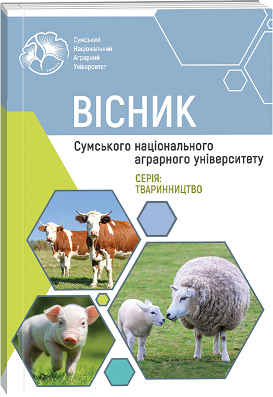HISTOSTRUCTURAL ANALYSIS OF MUSCLE TISSUE OF PUREBRED AND CROSSBRED PIGS
Abstract
The article examines the results of the study and analysis of the features of the histological structure of the muscle tissue of pigs during purebred breeding and crossbreeding. The conducted histological studies of the longest muscles of pigs of different breeds testify to the fundamental similarity of their structure. The differences come down to the different ratio between the connective tissue component of the muscle, adipose tissue and muscle fibers. In pigs, upon reaching 100 kg of live weight, the longest muscle of the back is dominated by polygonal muscle fibers with a diameter of 29-58 μm. Their share was from 67.6 μm (large white breed) to 71.7 μm (crossbreeds – large white x Myrhorodska). Small-diameter muscle fibers (up to 29 μm) in crossbreeds are less – 22.9% compared to large white – 28.7% and Mirgorod – 25.9%. On the transverse sections of the longest muscle of the back, muscle bundles of the first order, separated from each other by delicate layers of connective tissue, are clearly visible. Three to five such bundles are united by connective tissue layers into bundles of the second order, which in turn form bundles of the third order. In the longest back muscle of the large white breed, the connective tissue layers between the muscle bundles are less pronounced. In animals of the Myrhorod breed, these layers are much coarser and have a relatively small number of layers. A comparison of the data on the accumulation of intramuscular fat deposits between the studied groups of animals revealed a slightly lower percentage of fat on cross-sections of the muscle of pigs of the Myrhorod breed. No significant difference was found between piglets of the large white breed and crossbreeds. The VBxM crossbreeds have a slightly higher percentage of muscle fibers with a diameter of 29 to 58 μm and more than 60 μm. Crossbreeds have a relatively large number of small-diameter muscle fibers (up to 29 μm) – 22.9%. Some correlative relationships between the development of structural elements of muscle tissue and the performance of animals have been established.
References
2. Birta H. O. (2009). Histolohichni doslidzhennia naidovshoho miaza spyny svynei riznoho napriamu produktyvnosti [Histological studies of the longest back muscle of pigs of different productivity directions]. Poltava, Visnyk Poltavskoi derzhavnoi ahrarnoi akademii. Vol. 1, 62–65. (in Ukrainian).
3. Birta H. O. (2011). Morfolohichnyi sklad tush pomisnykh svynei [Morphological composition of domestic pig carcasses]. Poltava, Visnyk Poltavskoi derzhavnoi ahrarnoi akademii. Vol. 4, 72-74. (in Ukrainian).
4. Bondarenko V. V., Hlavatchuk V. A. (2011). Yakist miasa u svynei za vykorystannia u hodivli kormovykh dobavok: Monohrafiia [Meat quality in pigs due to the use of feed additives in feeding: Monograph]. Vinnytsia: RVV VNAU, (in Ukrainian).
5. Chang R., Wei Y., Ma L. (2010). The judgment of beef marble texture based on the MATLAB image processing technology. International Conference on Computer and Computing Technologies in Agriculture (Nanchang, October 22–25, 2010). – Berlin, Heidelberg : Springer, P. 106–112.
6. Chen J., Liu M., Zong L. (2012). The fractal dimension research of Chinese and American beef marbling standards images. International Conference on Computer and Computing Technologies in Agriculture. Berlin, Heidelberg: Springer, P. 199–209.
7. Chen K. Qin C. (2008). Fractal feature analysis of beef marbling patterns. International Conference on Computer and Computing Technologies in Agriculture. Boston (MA): Springer, P. 2177–2186.
8. Heyer A. (2004). Performance, carcass and meat quality in pigs еnfluence of rearing system, breed and feeding: doctoral thesis. Swedish University of Agricultural Sciences, Uppsala. 54 p.
9. Horbatenko I.Iu., Hyl M.I. (2011). Biolohiia produktyvnosti silskohospodarskykh tvaryn [Biology of productivity of agricultural animals]. Mykolaiv, (in Ukrainian).
10. Konovalov I. V., Lykhach V.Ia., Luhovyi S.I. (2011). Histolohichna budova miazovoi tkanyny svynei [Histological structure of muscle tissue of pigs]. Kherson, Tavriiskyi naukovyi visnyk. Vol. 76, 282–286. (in Ukrainian).
11. Kovalenko B.P., Shevchenko O.B. (2019). Otsinka yakosti miasa svynei riznykh henotypiv pry chystoporodnomu rozvedenni ta skhreshchuvanni [Assessment of meat quality of pigs of different genotypes during purebred breeding and crossing]. Veterynariia, tekhnolohiia tvarynnytstva ta pryrodokorystuvannia. Vol.3, 201-206. (in Ukrainian).
12. Kovalenko R.O., Yesina E.V., Povod M.H., Martseniuk I.V. (2010). Vplyv tekhnolohii vyroshchuvannia svynei riznykh henotypiv na histostrukturu naidovshoho miaza [The influence of technologies of raising pigs of different genotypes on the histostructure of the longest muscle]. Dnipropetrovsk. Visnyk Dnipropetrovskoho derzhavnoho ahrarnoho universytetu. Vol. 2, 103-105. (in Ukrainian).
13. Kramarenko O. S., Kramarenko S. S., Lykhach A. V., Lykhach V. Ya. (2019). Fraktalnyi analiz histostruktury miazovoi tkanyny svynei: poperedni rezultatyrezultati [Fractal analysis of the histostructure of porcine muscle tissue: preliminary results]. Harkiv, Naukovo-tekhnichnyi biuleten IT NAAN. Vol. 121, 146-156. (in Ukrainian).
14. Lykhach V. Ya., Lykhach A.V. (2019). Tekhnolohichni innovatsii u svynarstvi: monohrafiia [Technological innovations in pig farming: monograph]. Kyiv. FOP Yamchynskyi O.V., (in Ukrainian).
15. Rybalko V. P. (2006). Tendentsii i napriamy rozvytku svynarstva. [Trends and directions of development of pig farming]. Kyiv. Efektyvne tvarynnytstvo. Vol. 7, 7–11. (in Ukrainian).
16. Serrano S. Perán F., Jiménez-Hornero F. J. (2013). Multifractal analysis application to the characterization of fatty infiltration in Iberian and White pork sirloins. Meat science. P. 723–732.
17. Topiha V. S. Tribrat R. O., Lugovij S. I., Lihach V. Ya. (2008). Miasni henotypy svynei pivdennoho rehionu Ukrainy: monohrafiia [Meat genotypes of pigs of the southern region of Ukraine: Monograph]. Mykolaiv : MDAU, (in Ukrainian).
18. Tronchuk I.S. (2008). Fiziolohichni ta tekhnolohichni osnovy intensyfikatsii vyrobnytstva vysokoiakisnoi yalovychyny v Ukraini [Physiological and technological bases of intensification of high-quality beef production in Ukraine]. Poltava, Visnyk Poltavskoi derzhavnoi ahrarnoi akademii. Vol. 3, 60–66. (in Ukrainian).

 ISSN
ISSN  ISSN
ISSN 



